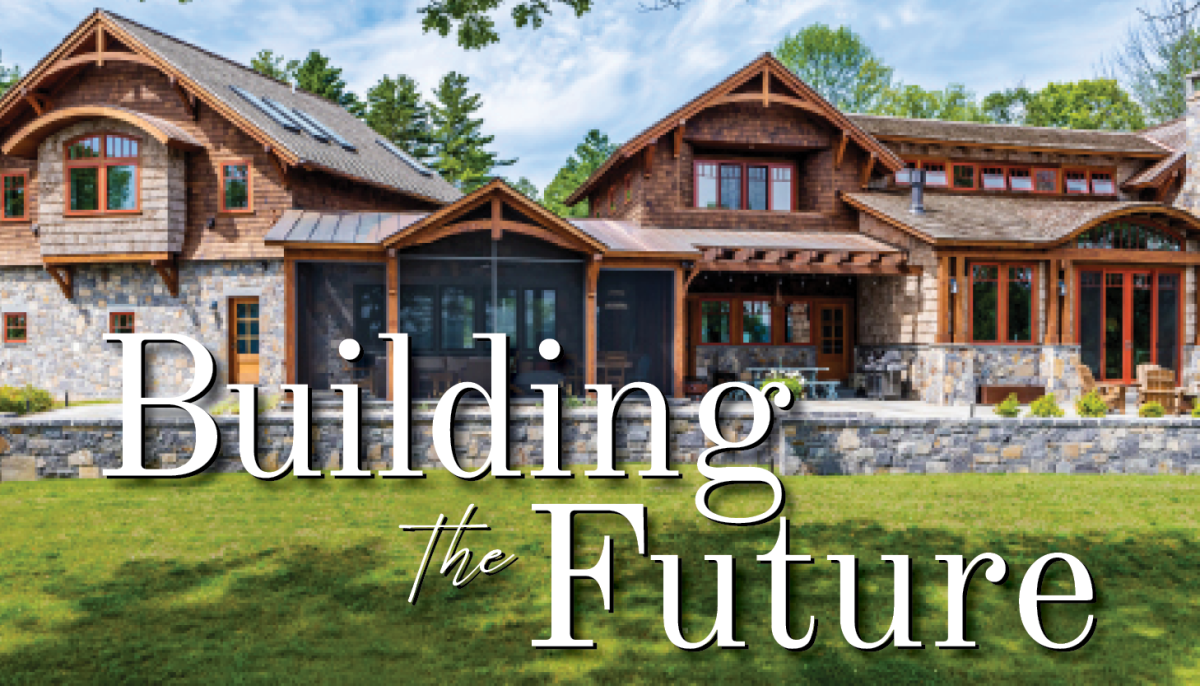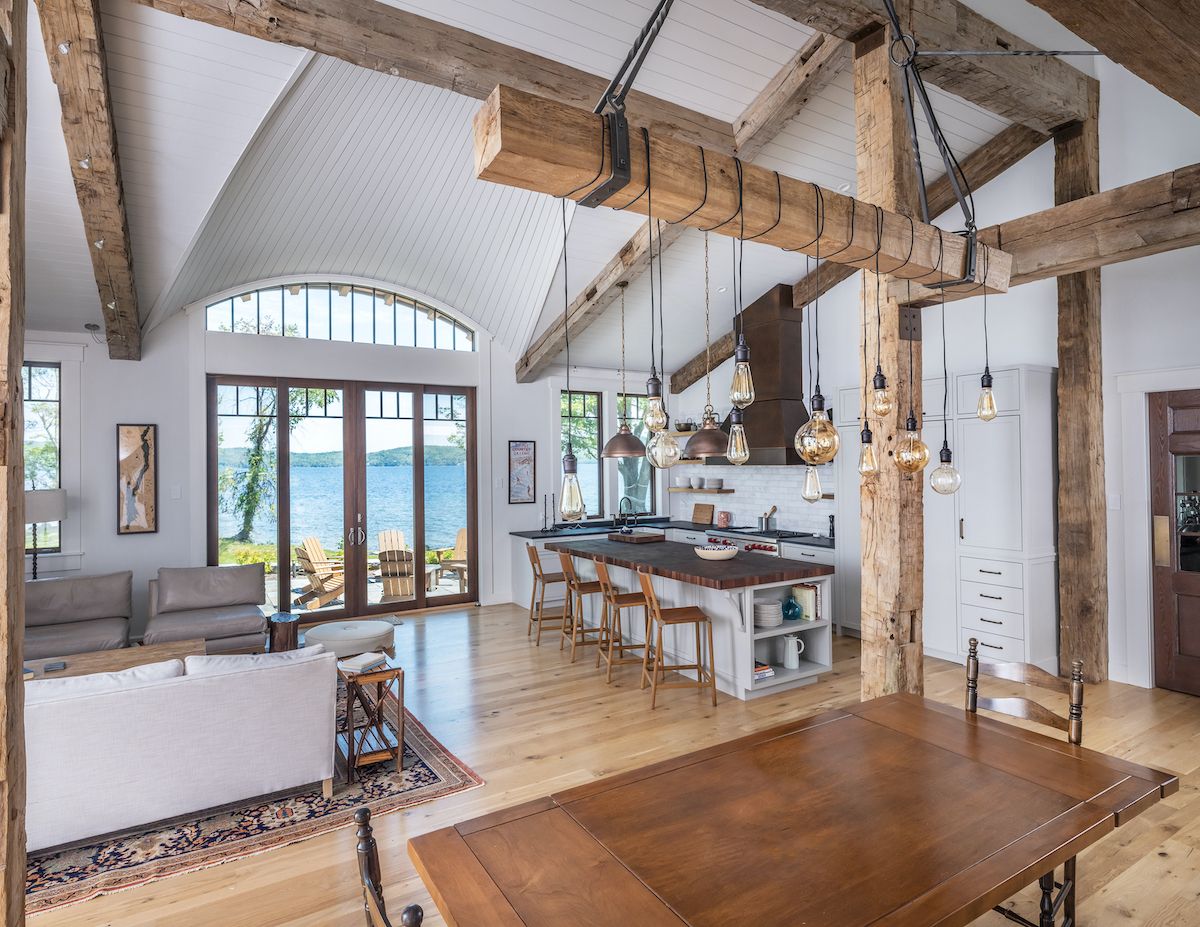
Lake side elevation. The stone retaining wall and patio create a connection from indoors to outdoors that united the entire house.
Natural materials and earth tone keep the house united with the natural world surrounding it. The curve of the great room window
acts as a detail carried throughout the house including the timber trusses, the garage bay window, and the front door.
How forward-thinking, ecologically
responsible construction empowers.
written By Megin Potter | Photos by Elizabeth Pedinotti Haynes
Sustainable design doesn’t
have to scream, I’m GREEN!
It can be accomplished with expert knowledge, clever choices, and a holistic approach. As Phinney Design Group has proven repeatedly in the past 20 years - good design never goes out of style.
Riding the Environmentally-Aware Roller Coaster
Growing up in Lake George, Michael Phinney loved the outdoors. His grandfather was the Mayor of Essex County, his dad ran a marina, and he became the fifth generation of his family to enjoy hiking, camping, boating, and fishing there. In the 1990's however, as a student at Rensselaer Polytechnic Institute (RPI) in Troy, he felt like an outsider.
“I had this desire to explore how architecture could coexist with,
and make, the environment better.”
- Michael Phinney, Principal Architect, Phinney Design Group
and make, the environment better.”
Michael’s thesis project at Rensselaer Polytechnic Institute (RPI) was on ‘Environmental Awareness in Architecture.’ As the Principal Architect at Phinney Design Group, founded in 2003, he has ridden the sustainable design roller coaster. Its popularity ebbs and flows, but its pinnacle was reached in 2001when then-Governor George Pataki issued Executive Order 111 instructing the state to adhere to energy efficiency goals. Michael worked on both the state’s first LEED-certified building, The Department of Environmental Conservation (DEC) located at 625 Broadway in Albany, NY, as well as the first LEED-certified building in the Adirondack Park.
Why Going Overtly “Green” Isn’t Your Only Choice
The Phinney Design Group is headquartered in the same sustainable building as The Local Pub and Teahouse, at the corner of Beekman St. and Grand Ave. in Saratoga Springs.
With a second office in Troy, the firm has amassed an accomplished portfolio spanning residential projects; popular restaurants including PJ’s Bar-B-QSA, The Local Pub and Teahouse, 550 Waterfront, Walt & Whitman Brewing, and the Common Roots Brewery and Tap Room; public spaces such as The Wild Center’s educational bio-building; as well as the historic preservation of behemoths including The Gideon Putnam, The Sagamore, Mohonk Mountain House, The Queensbury Hotel, and the Saratoga Race Course.

100-year-old reclaimed white oak timbers create the structure of the great room. The juxtaposition of the clean white walls and shiplap ceilings allow for the natural wood tones to draw focus.
Although sustainable design is Phinney’s niche, their primary goal is to educate clients. Currently, eighty-percent of their clients select designs including what Michael calls “common-sense” solutions that cost the same or slightly more than traditional techniques while minimizing negative impacts on the environment.
Ten percent opt for a slightly larger investment in windows, insulation, heating and cooling systems, appliances, and lighting, that will pay themselves off in energy savings within one to seven years. The final ten percent may choose to invest in greater energy saving technologies and more careful sourcing of all materials to achieve a net-zero energy building and/or zero-carbon construction. These investments can require eight years or more for a return on investment, but make a great impact on the environmental health of our world long-term.
Poised for the Second Wave
As new sustainability measures are rolled out, Michael anticipates a second wave of increased demand for environmentally-responsible design. Currently working on a net-zero mixed-use building in Troy, its three stories will showcase best-practices in an urban environment by reusing the existing structure, featuring state-of-the-art glass, and an all-electric commercial kitchen. Located along RPI’s pedestrian approach, the project is bringing Michael full-circle.
“It is interesting that here I am, 30 years later, building an example of something I dreamed about then. It’s very special.”
Rather than being the star player, today, Michael sees his role as more akin to that of a coach celebrating where the firm might go in the future, adding, “It’s not just me that makes the magic happen.”
When Climate Change Came Calling
Construction began on this 5,971 sq. ft., 5-bedroom, 4.5 bath home in late 2019. Situated on a small peninsula in Lake George’s Northwestern hamlet of Hague, it has 456 ft of shoreline providing breathtaking views from every room.
A large screen porch and curved blue stone patio allow the family to enjoy their spectacular location year-round. Wanting generations to have the same opportunity, there are safeguards built-in to protect the property, which is prone to flooding when the nearby brook overflows its banks.
Struck by an epic “500-year flood” during construction, the Phinney Design Group salvaged the existing structure by moving it further inland (reuse reduces the embodied energy inherent in disposal).

The fireplace acts a gathering point in the great room. Consisting of a custom stone pattern, reclaimed timber mantel, aged steel panels, and a handmade bronze door.
The new structure was raised 3.5 feet higher, covered with poplar bark siding and granite stone veneer that was sourced locally from Champlain Stone. Etched in the rock (which deters mold and mildew growth) is the layered story of the region’s geology. The stone repels moisture and promotes drainage into a continuous perimeter “drip strip” consisting of a perforated pipe buried two-feet beneath the ground, covered in locally sourced river-rock cobbles. These trenches then direct the water into the zero-maintenance rain gardens whose flowers bloom all summer long.
Additional environmentally-responsible features of the home include clerestory windows utilizing stack effect and evaporative cooling through natural ventilation and passive air exchange; the use of reclaimed white oak timber beams, salvaged doors, and transoms.
“Tying-in the local aesthetic vernacular with sustainable design is a win-win for everyone,” said Phinney’s Senior Architect Brennan Drake, who managed the project from design through the entire construction process. Phinney Design Group navigated both the epic flood waters and the pandemic’s strains on the supply chain to finalize construction by Spring 2022.
Contact Phinney Design Group at 518-587-7120 or phinneydesign.com